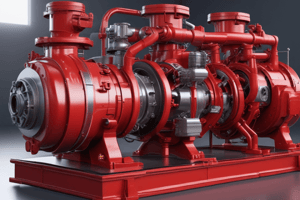Podcast
Questions and Answers
What does priming a centrifugal pump involve?
What does priming a centrifugal pump involve?
- Replacing the wearing rings, mechanical seals, and packing
- Adjusting the discharge valve
- Filling the pump casing and suction line with the liquid being pumped (correct)
- Cleaning the impeller of the pump
Why is it important to prime a centrifugal pump before starting?
Why is it important to prime a centrifugal pump before starting?
- To reduce the wear on the pump casing
- To increase the flow rate of the pump
- To prevent the impeller from churning air instead of producing suction (correct)
- To maintain the pressure in the discharge valve
What is the purpose of the foot valve in the pump suction line?
What is the purpose of the foot valve in the pump suction line?
- To allow water to enter the suction line and prevent it from flowing back out (correct)
- To reduce the noise produced by the pump
- To increase the temperature of the water
- To control the speed of the pump
What should be done to prime a centrifugal pump when it is located below the source of supply?
What should be done to prime a centrifugal pump when it is located below the source of supply?
What happens if a centrifugal pump is not primed before starting?
What happens if a centrifugal pump is not primed before starting?
What is the role of external supply valve when priming a centrifugal pump from an external source?
What is the role of external supply valve when priming a centrifugal pump from an external source?
Why are air vent valves opened when priming a centrifugal pump?
Why are air vent valves opened when priming a centrifugal pump?
What type of check valve is used in the pump suction line?
What type of check valve is used in the pump suction line?
What happens when water flows from the air vent valves during priming?
What happens when water flows from the air vent valves during priming?
What happens if a centrifugal pump runs dry even for relatively short periods of time?
What happens if a centrifugal pump runs dry even for relatively short periods of time?
What is the purpose of the foot valve in the suction line?
What is the purpose of the foot valve in the suction line?
What is the recommended action if the suction pressure gauge indicates the strainer is plugging when starting the pump for the first time?
What is the recommended action if the suction pressure gauge indicates the strainer is plugging when starting the pump for the first time?
Why should the alignment of the pump and its driver be rechecked after they have run for a short time?
Why should the alignment of the pump and its driver be rechecked after they have run for a short time?
What is the purpose of checking the driver and pump rotation before starting the pump?
What is the purpose of checking the driver and pump rotation before starting the pump?
Why must a separate hand-operated positive displacement priming pump be used in some cases?
Why must a separate hand-operated positive displacement priming pump be used in some cases?
What is a common reason for troubles developing in new plants after a short period of operation?
What is a common reason for troubles developing in new plants after a short period of operation?
Why should bearings be carefully inspected, cleaned, and lubricated before starting any pump?
Why should bearings be carefully inspected, cleaned, and lubricated before starting any pump?
Flashcards are hidden until you start studying




